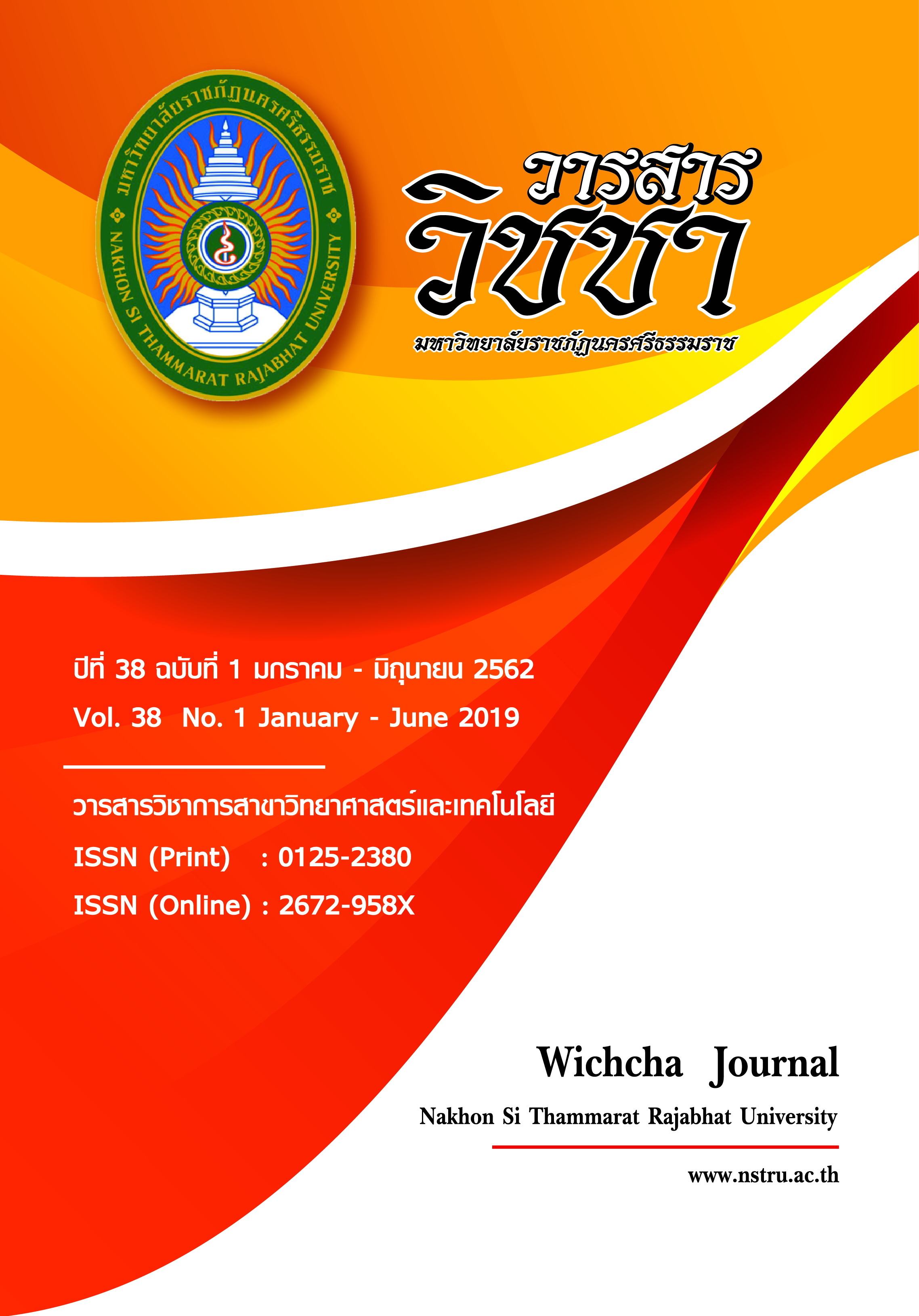Convective Hot Air Drying of Musa nana Linn. by LPG and Electrical Heating : Drying Kinetics, Quality and Energy Consumption การอบแห้งกล้วยเล็บมือนางด้วยการพาความร้อนจากก๊าซหุงต้มและ พลังงานความร้อนจากไฟฟ้า : จลนพลศาสตร์ คุณภาพและความสิ้นเปลืองพลังงาน
Main Article Content
Abstract
The main objective of this work is to investigate suitable strategy for Musa nana Linn. banana (Leb muea nang) drying with liquified petroleum gas (LPG) and electric hot air (HA) heating. The Musa nana Linn. banana drying experiments were carried on under the conditions of drying temperature ranging of 55-70 °C. Initial moisture content and average desired final moisture content of banana was in range of 250-300% and 20-25% dry-basis, respectively. The experimental results showed that the drying rate of banana sample depended on drying temperature. The specific energy consumption of the banana drying at high temperature was relatively low compared to those drying with low drying temperature. According to the physical qualities analysis in terms of colorness, percentage of shrinkage and sensory evaluation, the results showed that dried Musa nana Linn. banana with LPG has no significance in colorness measurement compared to the dried banana sample by electric heating. In contrast, percentage of shrinkage of the dried banana using LPG was slightly higher than the dried banana using electric heating. For sensory evaluation, the results showed that an overall acceptability of dried banana with LPG and Electric heating were insignificantly different from the reference dried banana by conventional heating (p < 0.05). In addition, the overall acceptability of dried banana was in moderate scale.
Article Details
เนื้อหาและข้อมูลในบทความที่ลงตีพิมพ์ในวารสารวิชชา มหาวิทยาลัยราชภัฏนครศรีธรรมราช ถือเป็นข้อคิดเห็นและความรับผิดชอบของผู้เขียนบทความโดยตรง ซึ่งกองบรรณาธิการวารสารไม่จำเป็นต้องเห็นด้วยหรือร่วมรับผิดชอบใด ๆ
บทความ ข้อมูล เนื้อหา รูปภาพ ฯลฯ ที่ได้รับการตีพิมพ์ในวารสารวิชชา มหาวิทยาลัยราชภัฏนครศรีธรรมราช ถือเป็นลิขสิทธ์ของวารสารวิชชา มหาวิทยาลัยราชภัฏนครศรีธรรมราช หากบุคคลหรือหน่วยงานใดต้องการนำข้อมูลทั้งหมดหรือส่วนหนึ่งส่วนใดไปเผยแพร่ต่อหรือเพื่อการกระทำการใด ๆ จะต้องได้รับอนุญาตเป็นลายลักษณ์อักษรจากวารสารวิชชา มหาวิทยาลัยราชภัฏนครศรีธรรมราชก่อนเท่านั้น
The content and information in the article published in Wichcha journal Nakhon Si Thammarat Rajabhat University, It is the opinion and responsibility of the author of the article. The editorial journals do not need to agree. Or share any responsibility.
References
จารุวรรณ กุลวิศว สมเกียรติ ปรัชญาวรากร และสมชาติ โสภณรณฤทธิ์. (2550). ผลของอุณหภูมิอบแห้งที่มีต่อสารระเหยง่ายและคุณภาพทางกายภาพในกล้วยแผ่น. วารสารวิจัยและพัฒนา มจธ., 30(4)(ฉบับพิเศษ), 611-621.
พรพรรณ รพี. (2530). ตารางแสดงคุณค่าอาหารไทยของกองโภชนาการ กรมอนามัย. สืบค้นเมื่อ 9กุมภาพันธ์ 2562, จาก: https://www.booktime.co.th/new/articledetail.php?t_id= 1403000022#.VGIuYvmsXoE.
สมชาติ โสภณรณฤทธิ์. (2540). การอบแห้งเมล็ดพืชและอาหารบางประเภท. กรุงเทพฯ: มหาวิทยาลัยเทคโนโลยีพระจอมเกล้าธนบุรี.
สำนักงานนโยบายและแผนพลังงาน กระทรวงพลังงาน. (2551). ก๊าซ LPG พลังงานสำหรับการหุงต้ม. สืบค้นเมื่อ 11 กุมภาพันธ์ 2562, จาก: https://www.eppo.go.th/encon./Publication/ word_files/AW_LPG_Update.pdf.
สุริยา อติวิทยาภรณ์ กมลวรรณ แจ้งชัด และอนุวัตร แจ้งชัด. (2551). การศึกษาเวลาที่เหมาะสมในการอบแห้งกล้วยตากแบบลมร้อนร่วมกับการอบแห้งด้วยคลื่นไมโครเวฟระบบสูญญากาศ. ใน การประชุมทางวิชาการมหาวิทยาลัยเกษตรศาสตร์ ครั้งที่ 46 (หน้า 612-620). กรุงเทพฯ: มหาวิทยาลัยเกษตรศาสตร์.
อนุรักษ์ ตรีเพ็ชร ปริญญา หม่อมพิบูลย์ เฉลิมขวัญ สมใจ มนตรี เรืองประดับ เปมิกา แซ่เตียวและณปภัช จันทรเมือง. (2559). เชื้อเพลิงแก๊สซิฟิเคชันจากวัสดุเหลือใช้ทางการเกษตร เพื่อผลิตไฟฟ้า: อีกทางเลือกของพลังงานทดแทนของภาคใต้. วารสารวิชชา มหาวิทยาลัยราชภัฏนครศรีธรรมราช, 35(1), 13-25.
AOAC. (2000). Official method of analysis. (16thed). Washington D.C.: Association of Official Agricultural Chemists.
Tasara, J. (2011). Optimum drying of standard Thai rubber (STR). Ph.D. Thesis in Chemical Engineering. Prince of Songkla University, Songkhla.
Thuwapanichayanan, R., Prachayawarakorn, S., Kunwisawa, J. and Soponronnarit, S. (2011). Determination of effective moisture diffusivity and assessment of quality attributes of banana slices during drying. LWT-Food Science and Technology, 44(6), 1502-1510.
Tirawanichakul, S., Na Phatthalung, W. and Tirawanichakul, Y. (2008). Drying strategy of shrimp using hot air convection and hybrid infrared radiation and hot air convection. Walailak Journal of Science and Technology, 5(1), 77-100.
Wilton, P., Cleide, M., Fernando, J. and Josivanda, P. (2014). Mathematical models to describe thin-layer drying and to determine drying rate of whole bananas. Journal of the Saudi Society of Agricultural Sciences, 13(1), 67-74.


